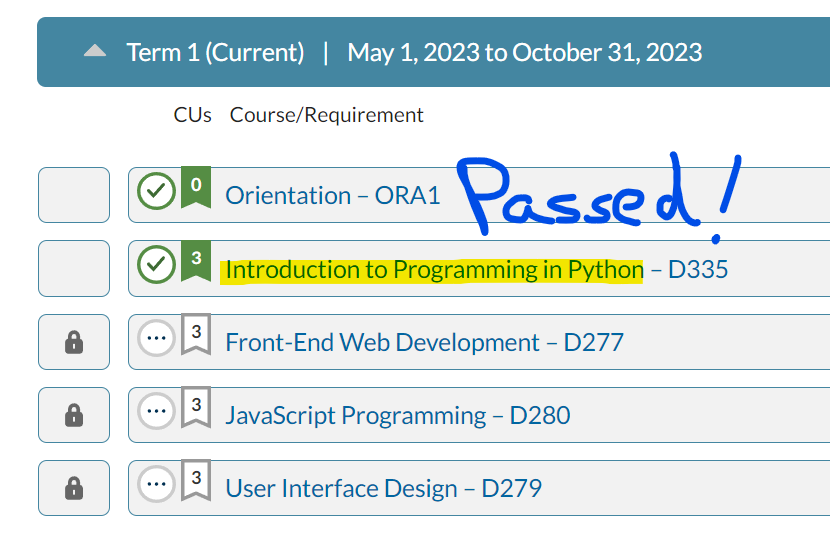Hey everyone! I’m excited to share the fantastic news, I passed my very first programming course at WGU! It’s been quite a journey, with its fair share of highs and lows, but I’m glad to emerge victorious at the end.
The grand finale was a live proctored assessment. It was my first time taking such a thing. But fear not! I followed every golden tip shared by my mentor, and guess what? It paid off big time! The whole experience went smooth without a hitch.
I had to tackle 16 mind-bending prompts in Python for the assessment. They threw everything at me, from the basics like string manipulation and loops, to more advanced tricks like working with modules and libraries.
The practice assessment I tackled the week prior served as a sneak peek of what was coming. While it wasn’t a carbon copy, it was similar enough so it did help. They sprinkled some extra challenges in the test to keep me on my toes. But thanks to my dedication and hard work, I solved each task with flying colors.
The test was designed to take around 3 hours, but I wrapped it up in 90 minutes! Don’t just take my word for it—check out the coaching report at the end of the assessment for proof.

This course has been a month-long adventure, and I’m kind of sad to bid it farewell. I’ve got a solid grasp of the fundamentals and can whip up some neat scripts, but I don’t think that’s going to take me far enough. I want to dive deeper, explore more advanced concepts, and create better programs. By year-end, my goal is to level up and become an intermediate Python programmer.
For Fellow WGU Students:
A lot of what I had trouble with in the actual assessment was related to opening, reading, and writing to files. Especially the CSV module to write to a csv file. One of the last questions is about implementing the csv module. You can read more about the CSV module here: https://docs.python.org/3/library/csv.html
Aside from that, here are a couple of pointers:
Creating Basic Scripts
1. You should be able to store variables of any data type (floats, strings, etc.) and know what their limitations are. For example, why would you want an integer as opposed to a float? If you try to round a float, how is it different from rounding an integer? Things like that.
2. You should be able to store and use variables in a way that can answer questions in a statement (For example: what is the average of three numbers?) Solution: average = sum / count.
3. User input! There were many times in the assessment where they asked me to save the user’s input in a variable. Make sure you are storing the input in the appropriate data type.
4. You should be able to manipulate strings and use F-String formatting.
5. Learn about the different data collection types: (such as lists, tuples, sets, dictionaries). What makes each one different? Why would you use a set over a tuple? Or a list over a dictionary?
Then after all that, you can delve into the Control Flow half of the assessment.
Control Flow
1. Learn about Functions and how to call them up later in the code. Also what caveats exist when functions return a result.
2. Know how to use IF’s, ELSE, and ELIF’s correctly in your conditional statements.
3. Get familiar with while loops and for loops. Know when to use one over the other. When is a while loop better than a for loop? What’s the difference?
Implementing Libraries
1. Learn to import libraries, which is essentially just using the ‘import’ statement. Pretty easy.
2. Use math library functions. Here is more info about the math library: https://docs.python.org/3/library/math.html (you will need to use some of these things in the assessment, so learn the most common ones at least.)
3. Finally, get really good at the built-in functions that Python comes with right out of the box. These are functions that you will use over and over throughout the course, such as: len(), input(), int(), abs(), range(), max() and min().
Those are my main pointers for getting the rudimentary stuff out of the way. If you need extra material or a more structured path, I recommend going through the lessons on RealPython.
This is the website: https://realpython.com/learning-paths/python-basics/
Also, I’ve condensed everything I learned in the D335 Python course in the following blog posts:
– Basics of Python Programming:
https://blog.rickp.dev/basics-of-python-programming/
– Basics of Python Programming, Pt. II:
https://blog.rickp.dev/basics-of-python-programming-part-2/
– Basics of Python Programming, Pt. III:
https://blog.rickp.dev/basics-of-python-programming-part-3/
Hopefully all of this helps!
Last Modified: October 11, 2024


Leave a Reply